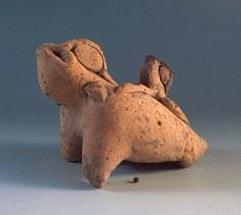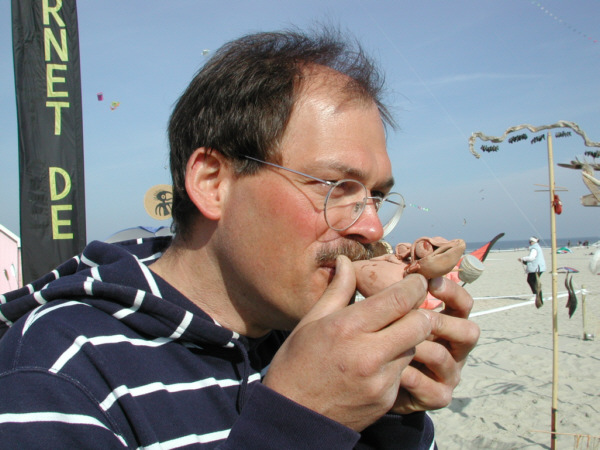
Clay Frog of Yaxchilan
Roberto Velázquez Cabrera
First version, February 4, 2003.Last version July 10, 2003.
Its ancient way of making is unknown. However, after the analysis of the ancient whistles, experimentation with a wide set of clay replicas and the test of several ways of making, it was found the best procedure to produce similar loud sounds to the frogs of Yaxchilan. As the ancient whistles produce beats, the volume of the resonating chambers must be different.
Construction procedure:
- Photo 1. Forming the body of the whistle using a mold of two pieces.
- Photo 2. Forming the two resonators with a separating wall.
- Photo 3. The molded body.
- Photo 4. Cutting the mouth with a little stick.
- Photo 5. Finishing the edge with a rounded stick.
- Photo 6. Molding the wind channels with two little sticks.
- Photo 7. Covering the wind channels with a little flattened piece of clay.
- Photo 8. Modeling the head in four pieces.
- Photo 9. Patching the head to the whistle body.
- Photo 10. Modeling and patching the legs.
- Photo 11. Drilling of the pitch holes with a little round stick.
- Photo 12. Patching of the modeled baby frog.
- Photo 13. Patching the head of the baby frog.
- Photo 14. Finished frog.
- Photo 15. Frog after burning*.
- Photo 16. Clay Frogs in different sizes.
* This replica was made for my friend Uli Wahl, expert on aeolian instruments, because he liked it very much. The replica was sent to him as a gift for his collection at Weinheim, Germany. He told me that the frog went to his last meeting at France where it was wecomed. He sent me some photos, including the following:

Photo of Uli and his clay frog in the meeting of "Aeolists" in Berck-Sur-Mer, at the Atlantic Coast, at the Channel, situated between England and France on April 15, 2003. Uli, his frog and friends from the meeting are in other photo.
Español


